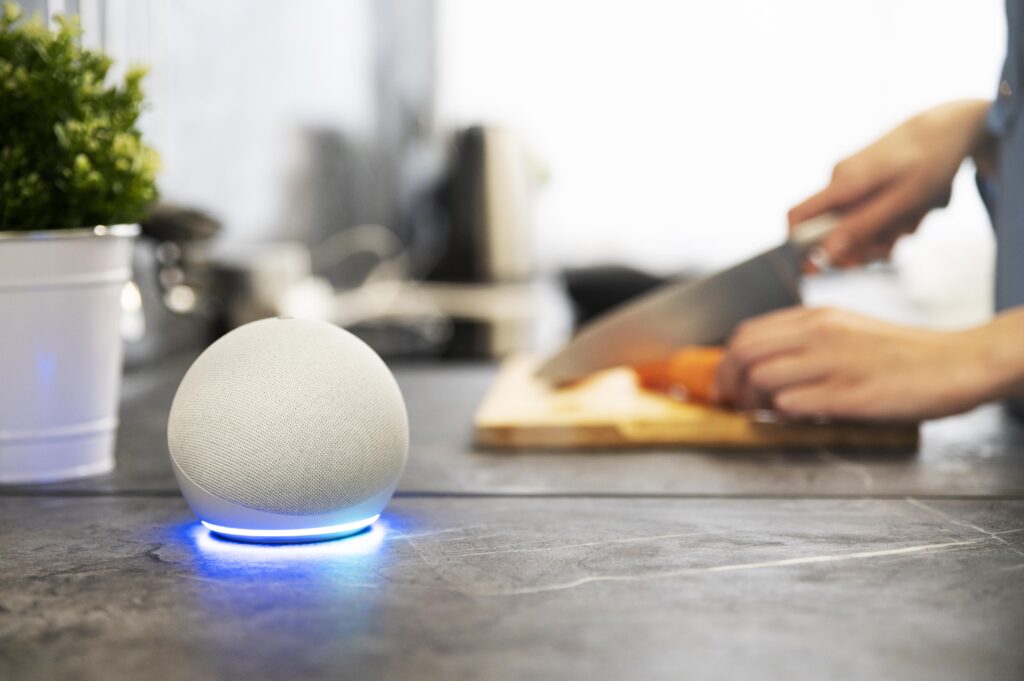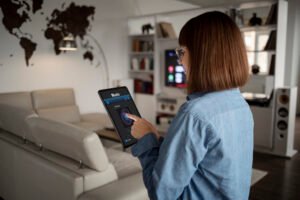FPGAs in Everyday life: As technology advances, the idea of “home” is changing. Making homes smarter and more efficient is a change that is led by Field-Programmable Gate Arrays, or FPGAs. These adaptable integrated circuits have made their way into common appliances, allowing for a degree of automation and creativity that was previously only possible in science fiction. This article examines the ways that FPGAs are transforming the contemporary home to make it safer, more efficient, and more networked.

FPGAs in Everyday
In terms of hardware design, FPGAs are revolutionary. Because FPGAs can be programmed and reprogrammed to do specific jobs, unlike fixed-function integrated circuits, they are ideal for the dynamic nature of modern homes. Their versatility, effectiveness, and security attributes have become them indispensable elements in the smart home movement. FPGAs are changing the way we live and interact with the world around us, from energy management systems and automation controllers to smart kitchen appliances.
Even though FPGAs have a lot of potential, integrating them into homes comes with some difficulties and worries. The article examines the possibilities and applications of FPGAs as well as the challenges that lie ahead as they lead us toward a time where homes serve as centres for creativity and connectivity rather than just as places to sleep.
FPGAs in Everyday | FPGAs in Home Appliances
FPGAs have become the unsung heroes of our modern homes, quietly but significantly enhancing the functionality and efficiency of everyday appliances. These adaptable integrated circuits are driving the smart home revolution by infusing intelligence into a wide array of household devices.
A. Smart Home Revolution
The cutting edge of home technology advancements is represented by smart appliances. Modern appliances like lighting systems, refrigerators, and thermostats can now interact, adapt, and generally make our lives easier thanks to FPGAs. Imagine if you will, a thermostat that remembers your preferences, voice-activated lights, or a refrigerator that tracks its contents and reorders goods. These appliances are capable of new degrees of automation and convenience thanks to FPGAs.
B. Enhancing Efficiency and Functionality
FPGAs are essential for improving household appliances’ functionality and energy efficiency in addition to their convenience. By maximizing energy use, these chips lessen their influence on the environment and utility bills. Washing machines equipped with FPGAs have the ability to regulate water usage according to the size of the load, and dishwashers may optimize cycles to get superior cleaning outcomes while using less power. FPGAs essentially improve appliances’ performance and environmental impact by allowing them to do more with less.
C. Safety and Security
The security and safety of our networked devices and data are guaranteed by the incorporation of FPGAs into home security systems. By strengthening security mechanisms, these chips thwart attempts at hacking and illegal access. They also make it possible for homeowners to remotely operate and monitor their property in real time, giving them peace of mind even when they’re not there.
The fact that FPGAs are found in common household products is evidence of their revolutionary potential. We will see firsthand how these chips are changing the fundamental structure of our houses and bringing in a new era of efficiency, security, and comfort as we dig further into individual case studies.
Case Studies
To truly grasp the impact of FPGAs in everyday appliances and the smart home ecosystem, let’s delve into some illuminating case studies that highlight their applications, benefits, and real-world implications.
Example 1: FPGA-powered Smart Kitchen Appliances
The Modern Kitchen Transformed
The addition of FPGAs has brought about a stunning revolution in the kitchen, the center of every home. These programmable chips enable smart kitchen appliances to offer a myriad of features that improve efficiency, personalization, and convenience in cooking and meal preparation.
1. Smart Ovens:
For example, consider the smart oven. Conventional ovens featured timers and fixed temperature settings. On the other hand, smart ovens with FPGA technology can adjust to various cooking methods and recipes. They have cameras and sensors built in to allow for real-time cooking process monitoring. To achieve the ideal outcome, the FPGA can modify the temperature and cooking time if your roast chicken is becoming overly brown. These ovens also have the ability to link to recipe databases and recommend the best settings for the food you’re cooking.
2. Smart Refrigerators:
FPGA-powered smart refrigerators are revolutionizing grocery management in the refrigeration industry. Built-in cameras in these appliances capture images of the contents of the refrigerator anytime the door is closed. This implies that you can use your time at the food shop to see what you have. They can also send you reminders when products need to be replaced or consumed because they keep track of expiration dates. They can also help with meal planning by making dish recommendations based on the ingredients that are on hand.
3. FPGA-driven Coffee Makers:
Your daily cup of coffee is enhanced by FPGA technology. FPGAs are utilized by smart coffee makers to adjust to your favorite brewing techniques, the kind of beans you use, and the strength of coffee you want. You can have your coffee ready when you get up thanks to a smartphone app that lets you manage them remotely.
These illustrations show how FPGAs have completely changed the way we use kitchen equipment. These gadgets’ flexibility and connectivity increase cooking’s efficiency, enjoyment, and personalization. They optimize cooking and grocery management, which not only saves time and energy but also lessens food waste.
Example 2: FPGA-based Home Energy Management Systems
Optimizing Energy Consumption for Sustainability
The integration of FPGAs into home energy management systems has far-reaching implications, not only for homeowners but also for the environment. These systems leverage the adaptability of FPGAs to optimize energy usage, reduce costs, and minimize the ecological footprint.
1. Energy Monitoring and Analysis:
Real-time monitoring of energy use patterns is possible with FPGA-equipped home energy management systems. They gather information from a number of sources, such as weather forecasts, solar panels, and smart meters. The FPGA may use this information to dynamically decide when to use renewable energy sources like solar panels, store energy in batteries, and get electricity from the grid. The optimal use of energy is made possible by this real-time analysis, which lowers costs and lessens reliance on fossil fuels.
2. Demand Response:
Demand response programs also heavily rely on FPGAs. These systems have the ability to modify how appliances operate during periods of high demand. For instance, the FPGA in your home’s energy management system might momentarily reduce the power usage of non-essential appliances like air conditioners and water heaters during a heatwave when electricity demand is at its peak. This can save a substantial amount of money on your energy bill in addition to lessening the burden on the system.
3. Sustainable Living:
FPGAs also give households the ability to live more sustainably. They can be easily integrated with electric vehicles, enabling smart charging that makes use of off-peak times. They also make it easier to maintain household battery storage, which may be used to store extra energy for usage in times of high electricity rates or power disruptions.
FPGAs in home energy management systems essentially enable homeowners to be frugal and environmentally aware. These systems serve as an excellent illustration of how technology may be used to solve pressing issues like growing energy prices and climate change.
Example 3: FPGA-driven Home Automation and Control Systems
The Hub of Home Automation
Home automation and control systems have experienced a remarkable evolution, thanks to FPGAs. These systems serve as the central hub for managing and controlling all smart devices in a household, ensuring a seamless and efficient experience for homeowners.
1. Centralized Control:
Automation hubs based on FPGA technology have the capability to combine the management of several devices, including entertainment systems, security cameras, smart lights, and thermostats. You can change settings, make schedules, and get real-time notifications all from a single interface. FPGAs’ versatility makes it simple to integrate new devices and work with a variety of protocols.
2. Personalization and Adaptation:
There is a lot of customisation available with these systems. You can write bespoke automation routines with FPGAs. For example, you can set your home’s temperature and lighting to match your daily schedule or preferences. The technology can adjust the lights and drapes to imitate your presence while you’re on vacation.
3. Voice and Mobile Control:
Voice recognition and interaction with virtual assistants such as Google Assistant and Alexa from Amazon are made possible by FPGAs. This implies that voice commands can be used to operate your home. Additionally, mobile apps offer remote control, so you may operate the appliances in your house even when you’re not there.
The foundation of a smart home is its FPGA-driven home automation system, which offers an easy and effective way to control all of the linked gadgets. They provide a preview of how houses of the future will be able to easily change to suit the needs and preferences of its occupants.
These case studies highlight how FPGAs may revolutionize home automation and increase energy efficiency and sustainability. FPGAs are not merely making our lives more convenient—from the kitchen to energy management and automation—but they are also radically altering the way we use our living areas.
Challenges and Concerns
While the integration of FPGAs in everyday appliances promises a more intelligent and convenient home life, it is not without its share of challenges and concerns. As with any technological advancement, there are important issues to address as we move towards a smarter home.
1. Security and Privacy:
The security and privacy of personal data is one of the main issues with appliances powered by FPGAs. For the purpose of enhancing their functionality, these gadgets frequently gather and send data. Vulnerabilities in the FPGA code could be exploited by hackers to obtain sensitive data or even take over home automation devices. To defend against such attacks, producers must put strong security measures in place.
Furthermore, concerns regarding the privacy of conversations held within the home have been highlighted by the usage of voice-activated technology in smart appliances. Users need to have faith that no one is abusing or intercepting their data. Tight data protection regulations, safe data transfer, and open privacy practices are necessary to address these privacy issues.
2. User Learning Curve:
Fast-growing smart appliance markets that rely on FPGAs may present difficulties for consumers who are not tech-savvy. These devices frequently have intricate app requirements, interfaces, and integration needs. Users need to devote some time to learning how to use and maintain these appliances in order to get the most out of them. Manufacturers must ensure that users, regardless of their level of technical expertise, have a smooth transition by creating user-friendly interfaces and offering thorough user guides.
3. Environmental Impact:
There are environmental effects associated with the manufacture, disposal, and use of FPGAs and the devices they power. The process of manufacturing integrated circuits requires a lot of energy, and the materials that are employed can have a significant carbon impact. In order to reduce electronic waste, appropriate recycling and disposal procedures for these gadgets must be in place when their useful lives are coming to an end.
Recycle programs and the use of more environmentally friendly materials are two ways that efforts are being made to lessen the environmental impact of FPGA technology. However, considering sustainable living and technology in a larger context, it continues to be a major concern.
4. Standardization and Compatibility:
The landscape of smart homes is made up of a wide range of products from different manufacturers, each with own standards and communication protocols. It may be difficult for many devices to function in unison due to this lack of standardization. Although cooperation and adherence to open standards are necessary, FPGAs have the ability to close the gap.
Customers desire appliances that can work together and interact with each other without being restricted to a single ecosystem. One of the biggest challenges facing the smart home business is achieving this interoperability while maintaining security and privacy.
Conclusion
Our homes are being revolutionized by the incorporation of Field-Programmable Gate Arrays (FPGAs) into common appliances, which makes them smarter and more efficient. The foundation of the smart home revolution, these reconfigurable integrated circuits allow gadgets to adjust to our demands. FPGAs are changing the way we live, from energy-efficient systems and automation hubs to simple kitchen gadgets.
However, difficulties and worries are approaching. Strong security measures are necessary to secure users’ data, and security and privacy concerns need our attention. Considerable attention must also be paid to the consumer learning curve, the environmental effect, and compatibility problems.
To fully realize the potential of FPGA-powered appliances and address these urgent issues, manufacturers, legislators, and consumers must work together as we move toward smarter homes. By doing this, we help to create a future in which our houses are safer, more aesthetically pleasing, more sustainable, and intelligent.


![What is FPGA Introduction to FPGA Basics [2023] computer-chip-dark-background-with-word-intel-it](https://fpgainsights.com/wp-content/uploads/2023/06/computer-chip-dark-background-with-word-intel-it-300x171.jpg)









